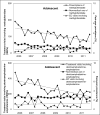Prescriptions, nonmedical use, and emergency department visits involving prescription stimulants
- PMID: 26890573
- PMCID: PMC5903919
- DOI: 10.4088/JCP.14m09291
Prescriptions, nonmedical use, and emergency department visits involving prescription stimulants
Abstract
Objective: Little is known regarding the temporal trends in prescriptions, nonmedical use, and emergency department (ED) visits involving prescription stimulants in the United States. Our aim was to examine these 3 national trends involving dextroamphetamine-amphetamine and methylphenidate in adults and adolescents.
Method: Three national surveys conducted between 2006-2011 were used: National Disease and Therapeutic Index, a survey of office-based practices; National Survey on Drug Use and Health, a population survey of substance use; and Drug Abuse Warning Network, a survey of ED visits. Ordinary least squares regression was used to examine temporal changes over time and the associations between the 3 trends.
Results: In adolescents, treatment visits involving dextroamphetamine-amphetamine and methylphenidate decreased over time; nonmedical dextroamphetamine-amphetamine use remained stable, while nonmedical methylphenidate use declined by 54.4% in 6 years. ED visits involving either medication remained stable. In adults, treatment visits involving dextroamphetamine-amphetamine remained unchanged, while nonmedical use went up by 67.1% and ED visits went up by 155.9%. These 3 trends involving methylphenidate remained unchanged. Across age groups, the major source for nonmedical use of both medications was a friend or relative; two-thirds of these friends and relatives had obtained the medication from a physician.
Conclusions: Trends in prescriptions for stimulants do not correspond to trends in reports of nonmedical use and ED visits. Increased nonmedical stimulant use may not be simply attributed to increased prescribing trends. Future studies should focus on deeper understanding of the proportion of, risk factors for, and motivations for drug diversions.
© Copyright 2016 Physicians Postgraduate Press, Inc.
Conflict of interest statement
Dr. Alexander is Chair of the FDA’s Peripheral and Central Nervous System Advisory Committee, serves as a paid consultant to IMS Health, and serves on an IMS Health scientific advisory board. This arrangement has been reviewed and approved by Johns Hopkins University in accordance with its conflict of interest policies. Dr. Mojtabai has received consulting fees and research grants from Bristol-Myers Squibb and Lundbeck Pharmaceuticals. Other authors declare they have no conflicts of interest.
Figures


Comment in
-
The ABCs of CNS stimulant misuse.J Clin Psychiatry. 2016 Mar;77(3):e315-6. doi: 10.4088/JCP.15com10102. J Clin Psychiatry. 2016. PMID: 27046316 No abstract available.
References
-
- Einhorn C, Huang J, Lavallee M. Their Own Words: ‘Study Drugs’. The New York Times; New York: 2012. Jun, Retrieved on Dec 1, 2014 at http://www.nytimes.com/interactive/2012/06/10/education/stimulants-stude....
-
- Drug Enforcement Administration, Department of Justice, Drug Enforcement Administration. ARCOS 2: Report 1, Retail Drug Distribution 2003
-
- McCabe SE, Knight JR, Teter CJ, Wechsler H. Non-medical use of prescription stimulants among US college students: prevalence and correlates from a national survey. Addiction. 2005 Jan;100(1):96–106. - PubMed
Publication types
MeSH terms
Substances
Grants and funding
LinkOut - more resources
Full Text Sources
Other Literature Sources
Medical

